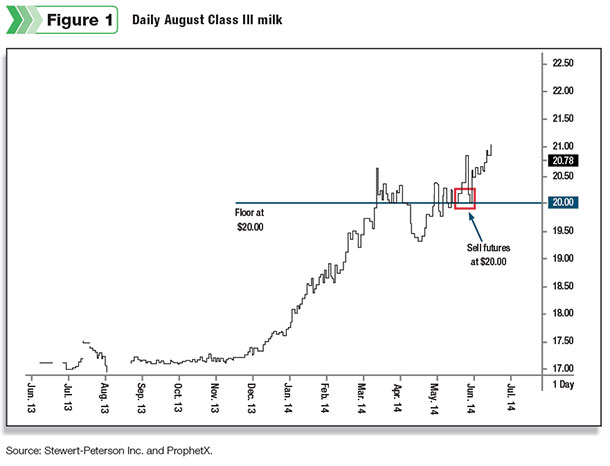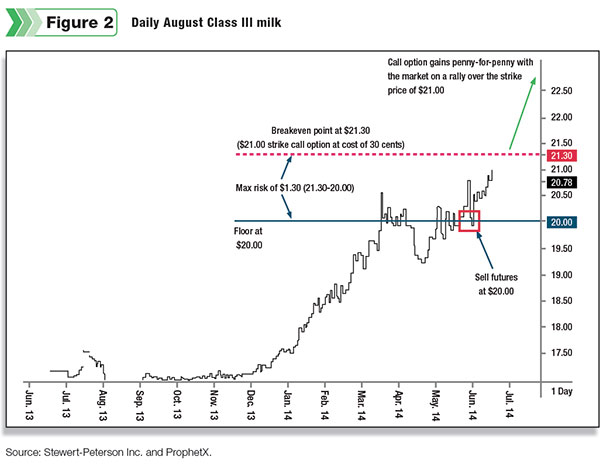You’re headed out to the state fair on a beautiful day, weather-wise. What do you carry with you? Your wallet? Keys? Those fit easily into your pocket. A water bottle in case it gets really hot? Maybe. A sweatshirt in case it gets cool in the evening? Probably a good idea.
You might not like having to carry things with you. It’s so much nicer not carrying anything as you walk around the fair. Yet, if you do not take these things along, you’ll end up paying $3 for that bottle of water and $30 for the best available (maybe even cheesy) sweatshirt to get you through the night.
Like the weather, our markets this summer have been variable, too. Soymeal prices climbed to an uncomfortable high of $509 before dropping down, as seasonably expected. Class III milk prices, although strong, have also seen volatility, posting some limit up and limit down days in May and June.
At the time of this writing, Class III milk has been bouncing around in a range between $19.48 and $21.28. That’s a swing of about $1.80 per hundredweight (cwt).
Some dairy producers feel that milk prices are in a comfortable range right now and have done little to protect these prices. Why should I carry protection if the weather (and the market) is comfortable right now?
By the time this story is printed, the market situation may have changed. Yet the lesson is the same: Use the tools available to you to protect yourself against extreme moves up or down. We never know for sure which way the market will go, so it is wise to consider and prepare for both scenarios.
When you are most comfortable, it is important to think about and prepare for what may come next. Once markets become volatile, as we are seeing this summer, it can be difficult to jump in and put some protection in place. Effective option strategies, for example, are expensive during times of high price volatility. Kind of like buying that $3 bottle of water at the fair.
There are strategies that can protect you and keep your dairy operation comfortable no matter what prices do. For many dairy producers, it’s just a matter of learning what those strategies are, what they are designed to do and being willing to carry them.
Here’s an illustration of a strategy that could have been used this summer when prices were bouncing around at the top end of the range. Seeing it depicted here may help you understand what’s possible if you and your adviser think creatively and use the tools at your disposal wisely. (The illustration below does not include commissions and fees.)
A protection example
When milk prices are at the extreme highs we have seen this year, a producer may want to put some protection in place to guard against a price drop. To get this done, you could buy a put option, which places a floor under your price.
This summer’s dilemma, however, is that the Class III milk price was so volatile that put options were extremely expensive. The price of a put option with a strike price of $20 (the floor you might want) is at a significant premium. The cost of a put with a strike price that is close to today’s prices may outweigh the benefits.
A better choice might be to sell a futures contract at, say, the $20 price level (see Figure 1 ). This price is chosen because it represents a likely floor in the range milk has been trading during the recent time period.

Now, if you sell a futures contract at $20, that is your maximum price received (minus fees and commission). Most producers want to be open to higher prices. A way to do that is to purchase call options that would give you the opportunity to participate in a Class III milk price rally if it happens.
The key is choosing a call option with a strike price that comes at a reasonable cost. Because of market fluctuations, options prices are changing all the time. For the purpose of this example, let’s say we choose a call option with a strike price of $21 and costing $0.30 (not including commission and fees).
A call option such as this would enable the producer to capture all of the price rally after milk hits the price of $21.30. (Actually, the producer would capture all of the price rally after the milk price hits the strike price of $21; however, we have to factor in the $0.30 premium price of the option before we would see the benefit of this strategy.)
So with this strategy, here is what we have, as depicted in Figure 2 :
- For the months that we sold the futures contract in the amount of $20, we have that as our floor price.
- Because of the call options we bought, if milk rallies to any price level above $21.30, we will receive all of that rally above the $21.30 mark. The gains on these call options would be realized upon liquidation or expiration of the call options.
Note that if the market rallies, the producer would also be responsible for margin calls on the futures contract through that rally; however, any gains realized from the call options could be used to effectively offset those margin dollars.
- For example, consider our sold futures at $20 and our $21 call option. If the market rallied to $23, you would be liable for $3 per cwt of margin calls. In addition, the $21 call option would have gained $2 per cwt of value, and that call option could be liquidated to capture that $2 gain.
Once that gain is realized, it could then effectively offset your $3 per cwt of margin calls and thus limit your margin risk to approximately $1 per cwt.
- Our maximum risk is the $1.30 “middle ground” between $20 and $21.30. If the milk price stays in this range, we will miss out on $1.30 per cwt. This is our “cost” of staying protected against the extremes.

This strategy creates the same protection as a simple put option strategy; however, it allows the producer to establish a higher price floor than a put option. The risk in using futures contracts is that your upside risk is essentially unlimited; adding the call option limits that risk and manages upside opportunity. The call protects the producer from missing out on a significant price rally.
It might be a little uncomfortable learning these strategies, just like it’s sort of annoying to carry along a sweatshirt and a bottle of water on a nice day. However, it’s important to know there are alternatives to weathering the extremes or paying through the nose for protection. You can learn how to walk around comfortably carrying a little protection from the extremes. PD
Futures trading is not for everyone. The risk of loss in trading is substantial. The information contained here is our opinion and believed to be accurate. There are no guarantees that a specific approach will translate into successful marketing.
These results are based on hypothetical performance results that have certain inherent limitations. No representation is being made that any account will or could achieve profits or losses similar to those shown.

Bob Devenport
Dairy Analyst
Stewart-Peterson Inc.






